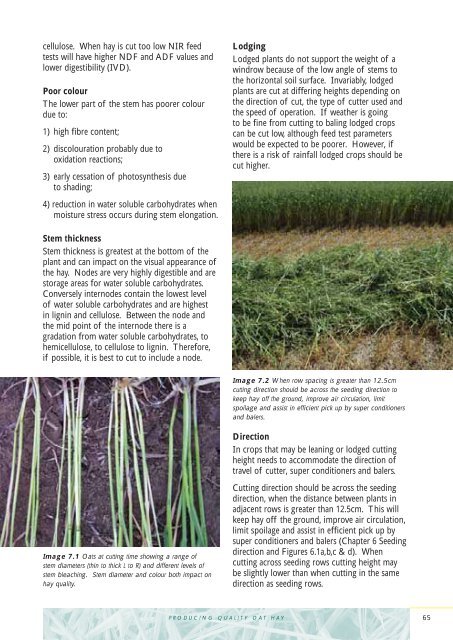Create successful ePaper yourself
Turn your PDF publications into a flip-book with our unique Google optimized e-Paper software.
cellulose. When hay is cut too low NIR feed<br />
tests will have higher NDF and ADF values and<br />
lower digestibility (IVD).<br />
Poor colour<br />
The lower part of the stem has poorer colour<br />
due to:<br />
1) high fibre content;<br />
2) discolouration probably due to<br />
oxidation reactions;<br />
3) early cessation of photosynthesis due<br />
to shading;<br />
4) reduction in water soluble carbohydrates when<br />
moisture stress occurs during stem elongation.<br />
Stem thickness<br />
Stem thickness is greatest at the bottom of the<br />
plant and can impact on the visual appearance of<br />
the hay. Nodes are very highly digestible and are<br />
storage areas for water soluble carbohydrates.<br />
Conversely internodes contain the lowest level<br />
of water soluble carbohydrates and are highest<br />
in lignin and cellulose. Between the node and<br />
the mid point of the internode there is a<br />
gradation from water soluble carbohydrates, to<br />
hemicellulose, to cellulose to lignin. Therefore,<br />
if possible, it is best to cut to include a node.<br />
Image 7.1 <strong>Oat</strong>s at cutting time showing a range of<br />
stem diameters (thin to thick L to R) and different levels of<br />
stem bleaching. Stem diameter and colour both impact on<br />
hay quality.<br />
PRODUCING QUALITY OAT HAY<br />
Lodging<br />
Lodged plants do not support the weight of a<br />
windrow because of the low angle of stems to<br />
the horizontal soil surface. Invariably, lodged<br />
plants are cut at differing heights depending on<br />
the direction of cut, the type of cutter used and<br />
the speed of operation. If weather is going<br />
to be fine from cutting to baling lodged crops<br />
can be cut low, although feed test parameters<br />
would be expected to be poorer. However, if<br />
there is a risk of rainfall lodged crops should be<br />
cut higher.<br />
Image 7.2 When row spacing is greater than 12.5cm<br />
cutting direction should be across the seeding direction to<br />
keep hay off the ground, improve air circulation, limit<br />
spoilage and assist in efficient pick up by super conditioners<br />
and balers.<br />
Direction<br />
In crops that may be leaning or lodged cutting<br />
height needs to accommodate the direction of<br />
travel of cutter, super conditioners and balers.<br />
Cutting direction should be across the seeding<br />
direction, when the distance between plants in<br />
adjacent rows is greater than 12.5cm. This will<br />
keep hay off the ground, improve air circulation,<br />
limit spoilage and assist in efficient pick up by<br />
super conditioners and balers (Chapter 6 Seeding<br />
direction and Figures 6.1a,b,c & d). When<br />
cutting across seeding rows cutting height may<br />
be slightly lower than when cutting in the same<br />
direction as seeding rows.<br />
65

















